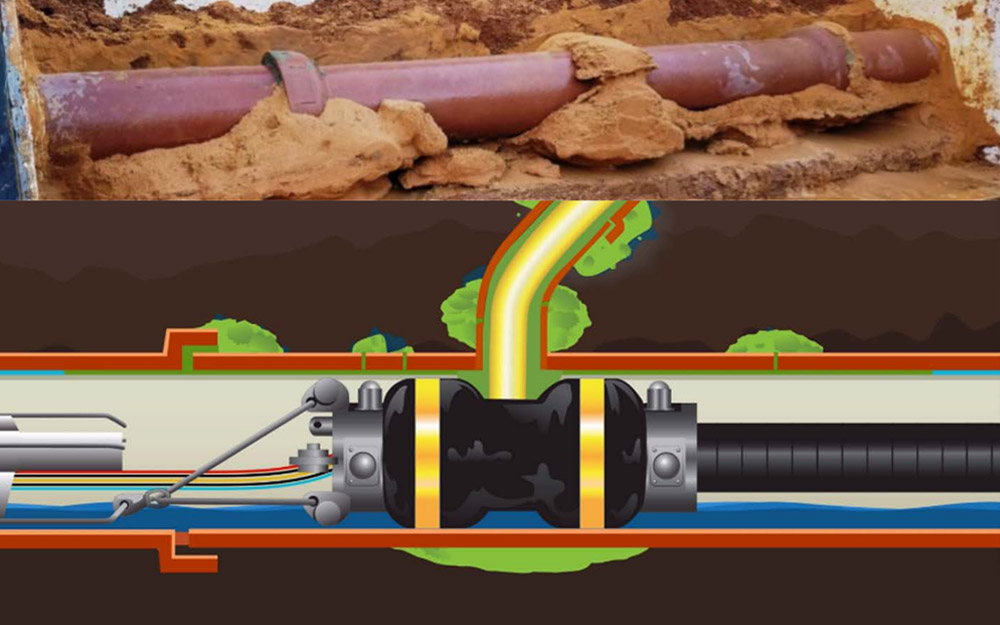The Requirements for Effective I&I Removal

The process of sewer system Inflow & Infiltration (I&I) removal requires a holistic approach to truly be effective. Specifically, all four points of infiltration must be addressed to achieve ultimate success. These four points are manholes, mainline joints, service connections, and service laterals.
Nearly all municipalities are constrained by budgetary limits for the annual amount of work that can be performed and are forced to make the decision to repair only certain items while leaving the remainder neglected.
Some concentrate only on mainline structural solutions as a widespread approach while others will tackle only segments with known impending failure. It sometimes becomes a balancing act of “How much can be done right or right now?” versus “What are my spending limits?”.
Addressing the Four Points of Infiltration
Returning to address I&I after a mainline structural solution such as CIPP has been installed is a decision that a lot of owners are facing. When a mainline pipe is lined, it becomes a new pipe within a pipe and extends the life of the original host pipe for decades.
However, since the original pipe remains in place, cracks, fractures, failed joints, and holes can remain. If there is no chemical or adhesive bonding, then an annular space between the host pipe and CIPP liner, if not a tight fit, may be present, and water may still enter the host pipe, flow within that space, and then reenter at reinstatements and manhole terminations.
However, since NASSCO and other industry specifications require a hydrophilic barrier at CIPP connections to mitigate the migration of infiltration in the annulus, infiltration typically does not freely flow through the annulus.
Grouting to Stop Post-Rehabilitation Infiltration
Sewer grouting is the process of eliminating infiltration through the trenchless installation of a chemical grout to the exterior of structures. When performed at lateral connections in conjunction with mainlines that have been lined with CIPP, grouting can be used to stop infiltration at the reinstatements.
The process begins when a sewer lateral packer is aligned with a lateral pipe. An inflatable sock is inverted into the lateral pipe, and mainline bladders and sock are inflated, isolating the connection at three critical points; two in the mainline and one inside the lateral pipe.
Air is then injected into the void space and, if air escapes, it is considered a failed joint. Acrylamide grout is then pumped into the area, flowing through the open joints to the exterior of the structure.
Having a viscosity very similar to water, the grout also flows into the annular space between the host pipe and liner. The grout then gels inside the CIPP annular space as well as on the exterior of the pipe, creating a water-tight seal.
Stopping post-rehabilitation infiltration at manholes is also achieved through injection grouting. A modern and common practice is to utilize a hydrophilic rubber seal between the host pipe and the liner at each manhole termination point. If the seal was not installed or the host pipe is cracked at the point of entry, water will enter.
Grouting practices can address these issues by drilling through the wall of the manhole and installing a curtain of grout around the structure. The grout technician will then inject grout into the space between the liner and host pipe, filling the gap, and creating a watertight seal.
The Benefits of Grouting
An added benefit to grouting is the creation of pipe stabilization and water stoppage within the sewer trench. A recent study by NASSCO’s Infiltration Control Grouting Committee (ICGC) has shown that as grout exits the structure, it immediately drops below the pipe and combines with the backfill materials to create a gel/soil matrix.
It then fills the void spaces surrounding the pipe in addition to creating a long-term seal around the defect or open joint.
NASSCO’s Grouting Specifications and USOPP
Specifications covering Pre-Rehabilitation Grouting and Capital Grouting practices were released by ICGC in October 2021 and are available through the NASSCO website along with an introductory video on grouting, and a new Unified Safe Operating Practices Program (USOPP) and accompanying online exam and recognition of knowledge. The USOPP is recommended for handlers, laborers, and inspectors who are involved in a grouting operation.